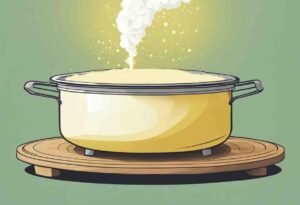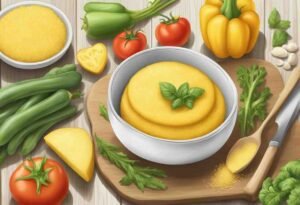Is Polenta Gluten Free?
Polenta Basics
In this part, we talk about what polenta is. We look at how it is made and the simple ingredients used. We also discuss how it doesn’t have any gluten.
What Is Polenta?
Polenta is a traditional Italian staple food that takes the form of a thick, savory porridge. Originating from Italy, it is versatile in its uses, serving as a main dish, side, or even a foundation for other recipes. Polenta shows how Italian cooking turns basic items into great food.
Key Ingredients in Polenta
The primary ingredient in polenta is cornmeal, which is derived from dried, ground corn. Authentic polenta uses a coarser grind of cornmeal, providing a robust texture to the dish. Essentially, polenta comprises two main ingredients:
-
Cornmeal: The type of cornmeal used is usually coarser than what is used for fine baking; it can range from fine to coarse ground.
-
Water: The cornmeal is cooked in water. This makes the grains bigger and gives polenta its creamy texture.
Some recipes use butter, cheese, or spices for taste. But polenta only needs cornmeal and water. The way it’s cooked, by stirring and simmering, turns these items into a comforting food enjoyed in Italy and other places.
Gluten and Diet
Knowing which foods have gluten and which are gluten free is key for those with celiac disease or gluten sensitivity. Polenta is a good choice for a gluten free diet.
Understanding Gluten
Gluten is a group of proteins found predominantly in wheat, rye, and barley. It helps foods keep their shape. People with celiac disease, an immune system problem, can hurt their small intestine if they eat gluten. Those with gluten intolerance or sensitivity may also feel sick after eating gluten. Gluten Content in Polenta
Polenta is a dish made from cornmeal, which is derived from corn—a naturally gluten free grain. When made with just water and cornmeal, polenta usually has no gluten. But people with celiac disease or gluten intolerance must make sure their polenta isn’t contaminated with gluten during processing. Polenta as a Gluten Free Alternative
Polenta is a flexible ingredient that can replace grains with gluten in many dishes. For instance, use it as a base for toppings in place of wheat-based crusts or serve as a side dish instead of wheat pasta. Due to its corn foundation and simple preparation process, polenta is a fitting and safe option for a gluten-free diet.
Choosing and Using Polenta
Choosing the best polenta brand and learning to cook it well are important for a gluten free diet. Making sure polenta has no gluten and cooking it right can make a simple dish great. Gluten-Free Polenta Brands
When picking a polenta brand, people should look for gluten-free labels first. This lowers the chance of contamination. A few reputable brands known for their gluten free polenta include:
-
Bob’s Red Mill: Certified gluten free and widely praised for consistency in cooking.
-
Roland Foods Polenta: Provides prepared polenta with a gluten free label, making it safe for people sensitive to gluten.
Always check the package for a gluten free label. The way it’s made could cause it to mix with grains that have gluten.
Preparing Gluten Free Polenta Dishes
Cooking polenta requires patience but is relatively simple. Basic steps for making gluten free polenta are:
-
Boil water: Start with a ratio of 4 parts water to 1 part polenta.
-
Add polenta: Whisk in the polenta steadily to avoid lumps.
-
Simmer: Stir often and cook until thickened to the desired consistency.
A basic polenta can be a canvas for various dishes, whether served creamy and soft or allowed to set and then baked, fried, or grilled. Here’s a simple recipe framework:
-
Creamy Polenta: Serve right after cooking, adding butter or cheese if desired.
-
Firm Polenta: Spread the cooked polenta in a pan, let it set, then slice for grilling or frying.
For those unable to find polenta or seeking a substitute, grits or coarse ground cornmeal can be used in a similar fashion. But make sure these options are also labeled gluten free.
Is Tequila Gluten Free? Exploring the Truth Behind This Popular Liquor
Frequently Asked Questions (FAQ’s)
The next parts give clear, factual answers about polenta and gluten-free diets. They are written for people with gluten sensitivities or celiac disease.
Can celiacs eat polenta?
Yes, people with celiac disease can eat polenta. It’s usually made from cornmeal and water, which don’t have gluten.
Is instant polenta gluten free?
Instant polenta is pre-cooked and dried so it cooks faster. It’s usually gluten free too, but always check the label for any gluten ingredients that might be added.
Is Bob’s Red Mill polenta considered gluten free?
Bob’s Red Mill polenta has a gluten-free label. This means it was made to avoid mixing with products that have gluten. This makes it safe for people with gluten sensitivities.
Does traditional polenta contain any gluten?
Traditional polenta does not contain gluten as its main ingredients are cornmeal and water. But when buying packaged polenta, check that no gluten ingredients were added.
Are there gluten-free polenta recipes available?
There are many gluten free polenta recipes available. These recipes use polenta that is naturally gluten-free. They also make sure all other ingredients, like cheeses and spices, don’t have gluten.
What distinguishes gluten free polenta from regular polenta?
Gluten-free polenta and regular polenta are essentially the same; both are made from ground corn. The important thing is making sure the polenta hasn’t been contaminated with grains that have gluten. This is key for a gluten-free diet.






